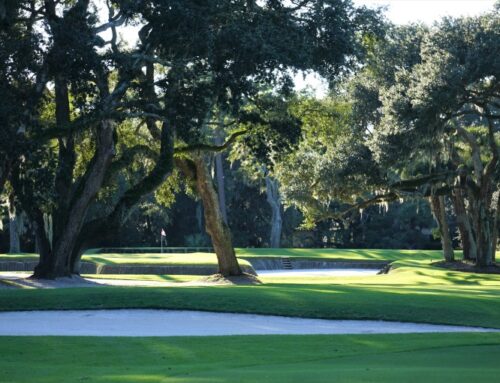Club at Clear Creek Tahoe
Nevada, USA
Green Keeper: Justin White

Though their first alpine setting, Coore & Crenshaw’s brand of architecture proved a perfect complement to nature in the Sierras.
Everyone benefits when property ends up with the right steward. Morse and Pebble Beach, Keiser and Bandon, and Youngscap and Sand Hills are but three examples whereby both something special was created initially as well as where the foundation was put in place for these iconic destinations to flourish for decades to come. As this relates to Clear Creek, several developers tried for a decade to make the most of a 1,600 acre parcel of land on the Nevada side of Lake Tahoe near Incline Village and Glenbrook. Not until Jim Taylor and his partner Chip Hanly became interested in this south-facing land in 2006 did things turn for the best.
The original developers had various architects including Nicklaus, Norman and Bobby Jones Jr. do routings but none of those projects proceeded. However, a general routing was granted permitting by Douglas County during this process, which is no small accomplishment given its location in the Sierras. Once Taylor and Hanly took control of the project, talks were held with two more lead architect firms but eventually Taylor talked Bill Coore into having a look. Over the phone, Bill Coore explained his reservations to working in a mountain setting including landforms that are typically too severe for good golf and poor soil quality. Nonetheless, he agreed to come up from his base in Arizona and Taylor picked him up from the Reno airport. As Taylor drove Bill Coore up the steeply inclined Highway 50 near the property, he could sense Bill Coore losing interest. After all, Bill Coore was thinking if the site featured slope like this, they would pass on the project as it would mean altering nature beyond a point in which they are comfortable.
After a quick detour to the Club’s Lake House, Bill Coore asked to be dropped at the site at 10:00am and for Taylor to please come pick him up around 5:00pm. Bill Coore‘s initial walk was such that he stayed the next day – and the next – and the next! During his visits in the evenings with Taylor and Hanly, Bill Coore appreciated the obligation that they felt toward showing great respect for the land and in being careful stewards. In addition, when asked by Bill Coore what they wanted from the course, the unhesitating answer back was that they wanted the player refreshed after the day’s first round and eager to play more. Hosting televised events was the furthest thoughts from their mind. Both answers pleased Bill Coore to no end as he was free to create engrossing golf on the ground without wondering what it might look like from a camera crane.
After two more five day trips of just studying the land, Bill Coore finally felt he had found a course and was comfortable to proceed. For its part, Douglas County was quite pleased with Coore & Crenshaw‘s routing as it condensed the course and used nearly ten acres less of land than the routing that they had already approved. Indeed, including the large, first rate practice area, the course only has a total of fifty-five acres of turf. Details were quickly squared away and Coore & Crenshaw‘s talented team with James Duncan as the project manager started shortly thereafter in June, 2007.
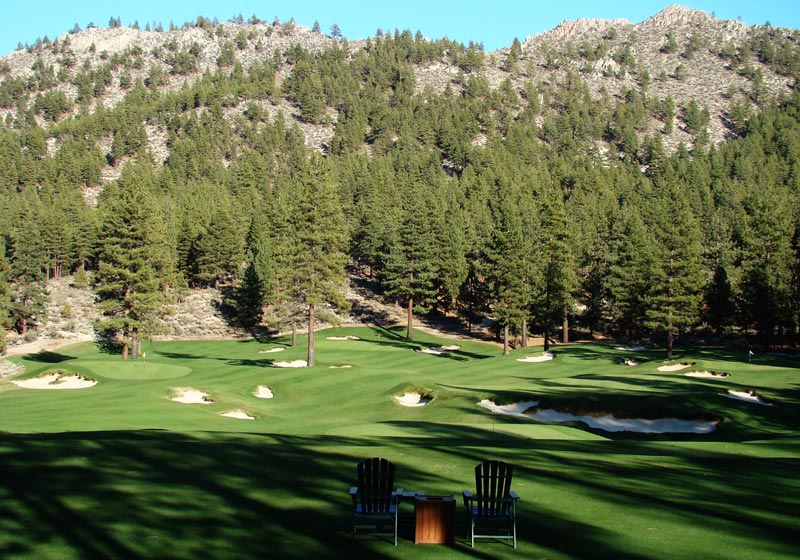
Even including this world class practice area, the golf takes up only fifty-five acres of maintained turf. Though Coore calls this ‘the prettiest practice area I have ever seen’, he is quick to point out that club president Mark Sollenberger (an Arizona Hall of Fame golfer) designed it with the help of the Coore & Crenshaw’s talented shapers – Bill and Ben had nothing to do with it. Golfers happily wile away hours here honing various aspects of their game.
In terms of the quality of the soil, this was never the issue that one might expect. Indeed, on his first visit, Ben Crenshaw bent down and grabbed a handful and let it shift through his hands. Appreciating that this ancient soil was a combination of decomposed granite and sand that was five to thirty feet deep around the property, Ben Crenshaw turned to the developers with a gleam in his eyes, exclaiming, ‘This soil is gold!’ Because of its sandy loam qualities, the decision was made to use the site’s natural soil in creating all the tees and push-up greens and to eschew building greens to USGA specifications. Having the right Green Keeper on board was crucial and that was solved when Justin White from The Sand Hills came over and joined the team.
At 1,600 acres, the property at the Club at Clear Creek is clearly expansive. However, humble as always, Bill Coore makes it clear that’s not to say that there were a number of ways to route eighteen holes around the property and have all the holes play well. Of the five architects that had done routings over the past ten years, there were areas of commonality with the final routing that exists today. For instance, the various routings all featured holes roughly where today’s fifteenth and eighteenth holes are. From Coore & Crenshaw‘s perspective, the breakthrough moment in the routing came when they became comfortable in building the dramatically downhill third hole, which nearly takes the golfer from the high to low point on the course in just one hole. This is not a typical Coore & Crenshaw hole but it certainly does make for one of the course’s more memorable drives.
With the routing established, the primary challenge presented to Coore & Crenshaw was in building greens that represent good golf. Greens like the second, fourth, ninth, tenth and fifteenth sit peacefully upon the land today yet required quite a bit of skill and work to make them play properly. Take the second for instance. Placing the green at the base of the rock outcroppings was an easy decision once they committed to building the third hole. However, given the natural back to front pitch of the land, making the green play and look right wasn’t easy. Prop the front portion of the green up too much and it will never appear right to the golfer’s eye from the tee below. However, don’t do enough and golf balls will never find a place to rest and will continually roll off the green’s front. As seen below, the green that was finally constructed visually fits in with its surrounds while still playing well, even when the club permits the greens to run at 12 on the stimp for special events.
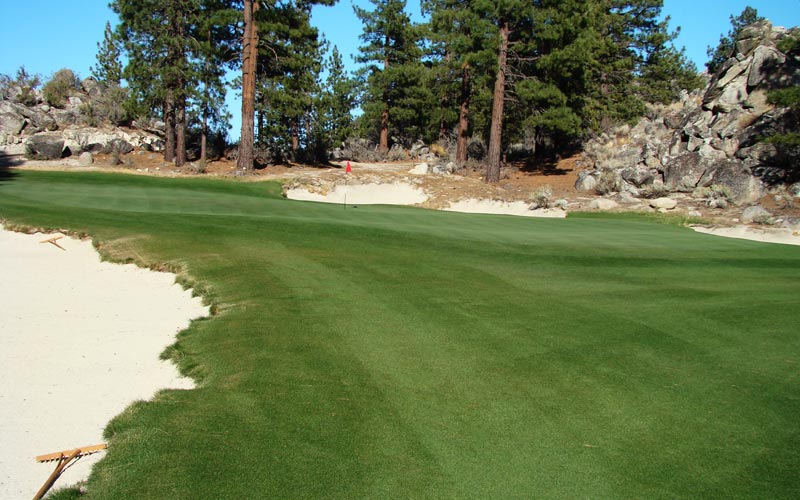
The second green may look effortless now but it took a lot of thought and effort to get it to play right. As an aside, the heavy wooden rakes speak as to the attention to detail present at Clear Creek.
The tenth is another green complex of great beauty. Fill was required as Coore & Crenshaw decided to keep pulling the putting surface forward but they tied it off so nicely with the natural grade in the back and surrounds that the golfer can be forgiven for thinking it was a natural site and that Coore & Crenshaw did little. In part because the greens have so much character, the course has no obvious weaknesses. Most courses have three or four transitional holes that lead the player from one part of the property to another with the transitional holes not quite of the same standard as the rest. As we see below, that’s not true here as the holes are all of a high quality rarely found in golf, modern or otherwise.
Holes to Note
First hole, 520 yards, Quiver; Ideal opening holes make the golfer want to get out and play, in part by revealing appealing design attributes that carry through the rest of the holes. In this case, the golfer hits his opening drive over the natural forest floor to a forty-five yard wide fairway that bleeds into the native areas. No two to three inch rough borders this or any fairway – the ball is either on the short grass or the natural forest floor, which is as it should be given that any band of rough would be unnatural/linear in appearance. Up ahead, the green is bunkered only on one side with the short tight grass to the green’s right giving golfers of all ability room to play.
Second hole, 180 yards, Rock Garden; Clear Creek is very much a position golf course, in particular with great thought required as to from where the first putt should be struck. Staying below the hole is important, especially at uphill greens like this one which provide the easy opportunity for the architect to incorporate back to front slope (see the sixth green for another such example). In addition to the general slope of the land/green, a Perry Maxwell ‘puff’ exists in the middle section of the green, creating some unusual putting predicaments for those that get out of position. David Zinkand and Jim Craig deserve tons of credit for their work in making the set of greens at Clear Creek so special.
Third hole, 510 yards, Aerie; At 5,830 feet of elevation, the third tee is the high point on the course. Almost 200 feet below (!) is the green, making it (after the fourth) the lowest green on the course. Though the tee ball is what most remember, traditionalists take equal delight in the open green site and the variety of shots that it accepts.

The sight of a well struck tee ball lingers in the golfer’s mind as he recalls watching it hang in the air seemingly forever. At over fifty-five yards in width, the third fairway needed to be one of the widest on the course as otherwise, it would seem puny and restrictive, undermining the spacious feel that the golfer soaks in while standing on the tee.
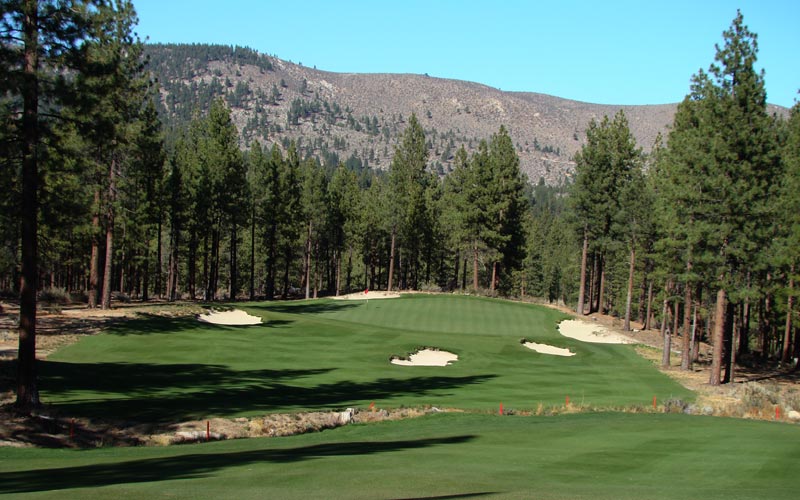
The dry ditch that diagonally cuts across the third fairway 100 yards prior to the green is a consideration for anyone who doesn’t get off a good tee ball. Don’t be fooled into under clubbing by the middle bunker as it is twenty paces from the front edge of the green.
Fourth hole, 200 yards, Tuning Fork; Every course has spots where the golfer simply can’t miss it and one of those at Clear Creek is to the right of the fourth as the ground falls away. True to good design principles, Coore & Crenshaw give the golfer plenty of room to the left to work balls in and the carefully conceived green contours help feed balls to the right hole locations. Given the site’s altitude, holes of this length are a fine way for the architect to insure that the golfer hits in a range of clubs into greens.
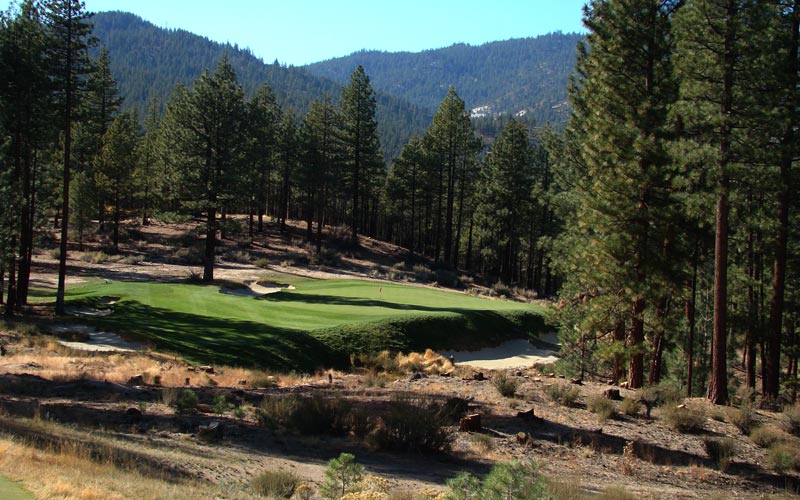
Lake Tahoe is straight over the mountains ahead and when the wind comes off it, this already tough one shotter becomes a beast.

The sloping ground high left of the green is the golfer’s friend; the sloping ground low right is NOT!
Fifth hole, 335 yards, Conundrum; After the steep drop at the third, the fourth takes the golfer to the lowest spot on the course. Both the third and fourth holes enjoy stirring qualities and needed to be built. Nonetheless, a challenge from here for Coore & Crenshaw was how to get the golfers back up on this walking friendly golf course. The risk is that the architect builds holes that play too hard because of their uphill nature, leaving the golfer feeling dejected and worn out. Avoiding that mistake, they designed as the next two holes a short par four and reachable par five, both with teasing qualities that are fun to play.

As seen from the right of the fairway, options abound at the short fifth. Can the golfer carry the two left bunkers that are on the direct tee to green line? If so, he’ll enjoy just a flip wedge into an open green. Or perhaps lay up near the base of those bunkers where the fairway affords a level stance and the same fine angle? Of course, the easiest drive is to the middle of the wide fairway but that means avoiding the tiny central bunker seen above. Though its footprint is small, Coore & Crenshaw massaged the surrounding land so that it does nothing but funnel balls into it, thus making it play effectively much bigger.
Sixth hole, 515 yards, Turning Point; Sharing some similarities with the great fourth at Bethpage Black, this three shotter swings left and the golfer isn’t aware from the tee just how much the hole climbs. Ala Tillinghast at Bethpage, the bunkers that were cut into the upslope of the fairway give the hole its strategic merit.
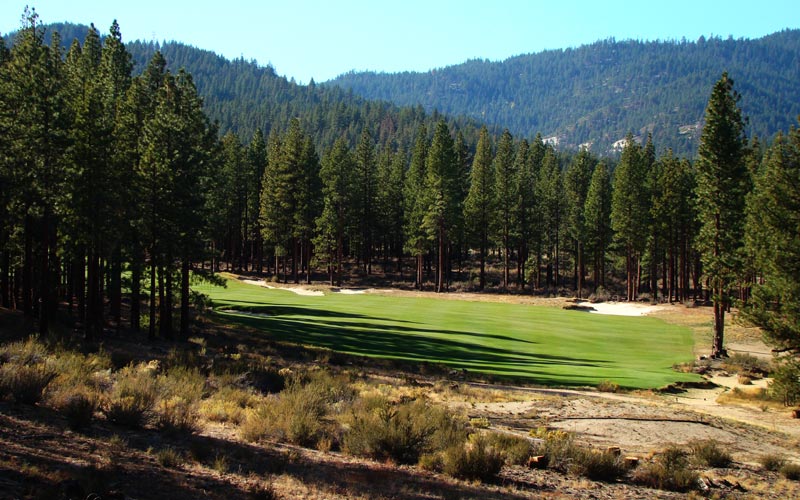
A draw is the friend of any right handed golfer on the dogleg left sixth yet he needs …
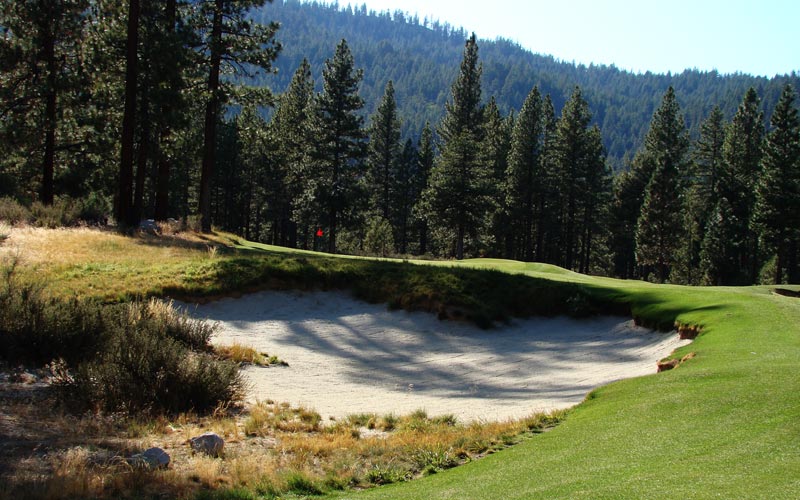
… this one farther ahead that is eighty yards short of the green.
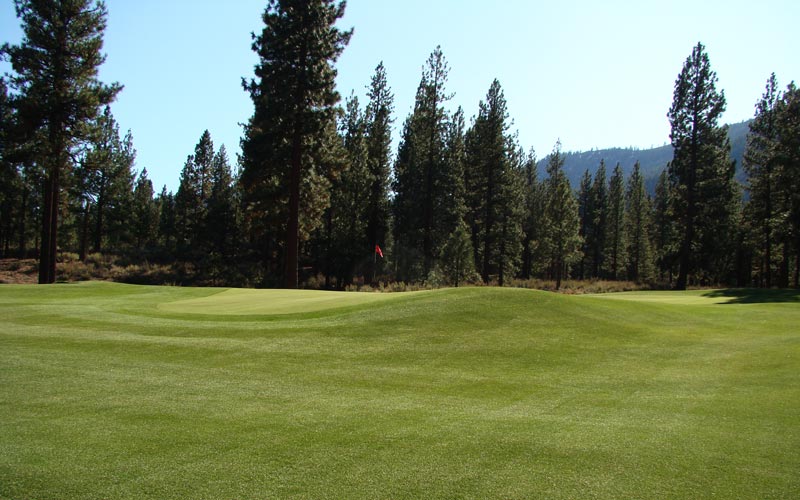
Alas, as seen from short front right, the sixth green features a fearsome amount of back to front pitch as well as a false front. Just being near the green in two is little guarantee of obtaining the desired birdie.
Seventh hole, 460 yards, Relentless; After a couple of potential birdie holes, the golfer faces this brute. Despite the unyielding nature of the uphill approach shot, one of the most fun green contours greets the golfer, namely a three foot plus rise in the back right corner of the green that helps acts as a brake and propels approach shots back toward central hole locations. This is a fine example of Coore & Crenshaw using what nature gave them (i.e. a natural saddle for the body of the green) while also enhancing it for golf by the use of this mound to help the golfer on this frequently downwind hole.
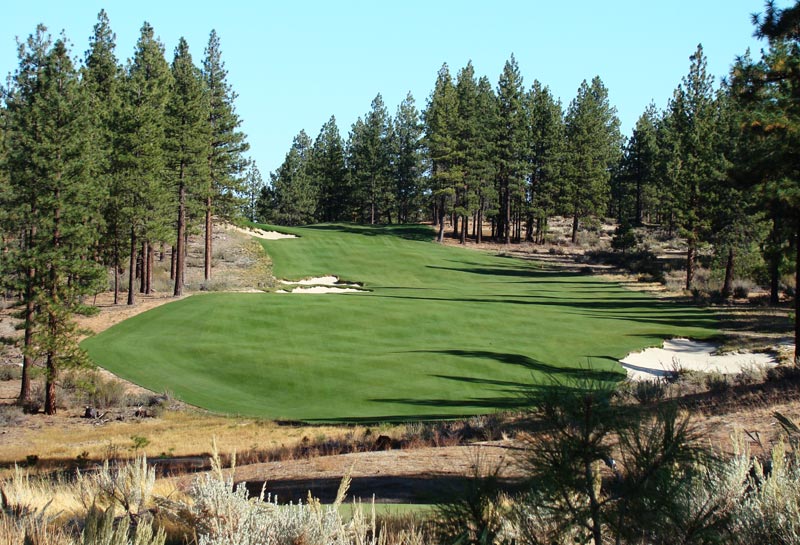
Though uphill, the prospect standing on the seventh tee is pleasing rather than daunting.
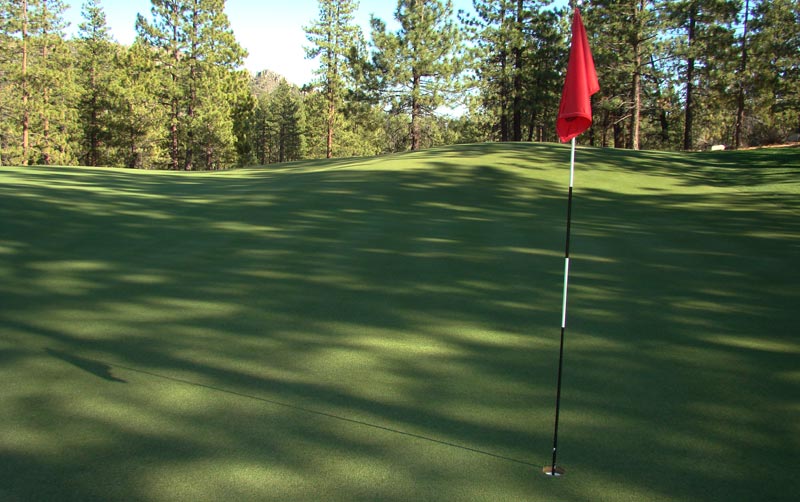
The saddle green collects balls toward the middle of the putting surface and helps make this uphill hole a reasonable proposition for most golfers.
Eighth hole, 170 yards, Deception; After three successive uphill approach shots that require precision, the golfer rightly takes comfort when he steps onto this tee and sees a downhill hole whereby the high right side of the green surrounds can be used to gather shots onto the putting surface.

Lining up the eighth hole with this view was a shrewd move by the architects.
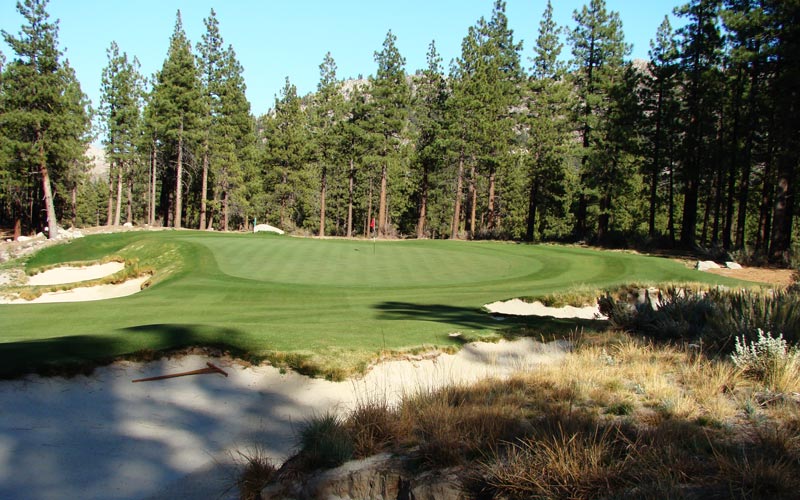
Properly judging the broad breaks in the eighth green is tricky business.
Ninth hole, 445 yards, Gunsight; Coore & Crenshaw are in the enviable position of being selective for whom they work, only undertaking two or three projects at any one time. Apart from seeing potential in the property, they have to sense a commitment from the owners toward long term quality. They enjoyed that here in spades and one design example is in the effort to pull the tongue of the fairway over the crest of the hill so that the golfer enjoys a good view.
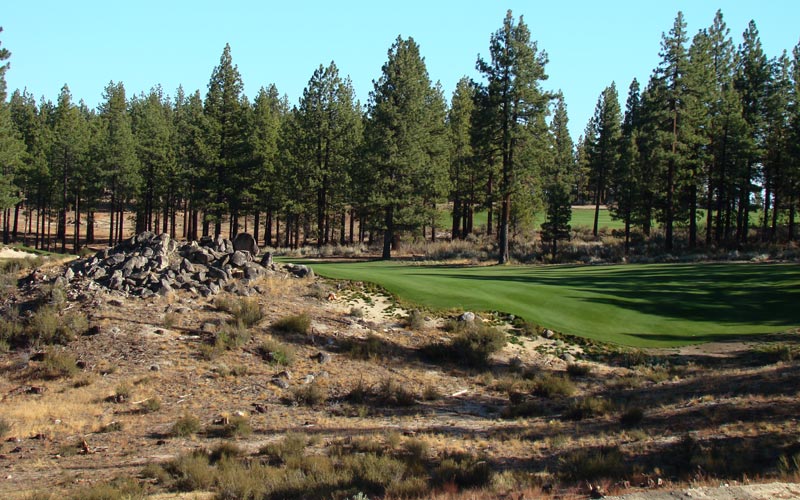
The sandy soil, rocks, and native grasses provide wonderful contrast against the verdant fairway. As the golfer walks around the bend …
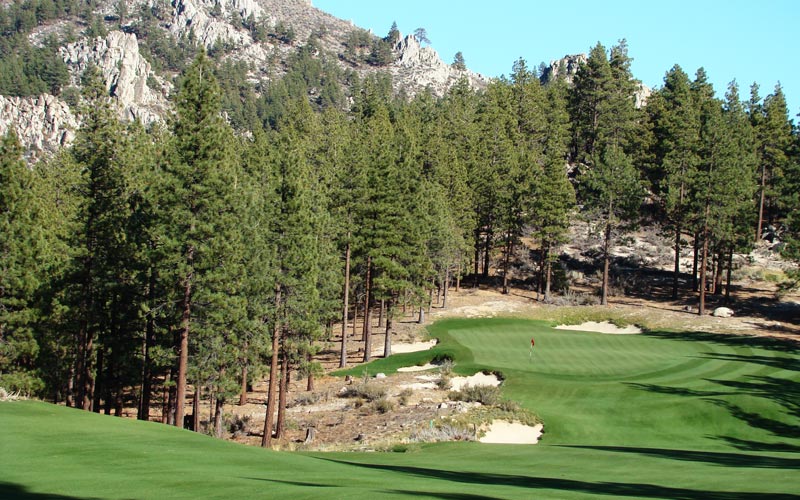
… one of the most unforgettable views on the course unfolds. Note the red flag and how much putting surface is seen above it, a sure indication that this is one extraordinary green!
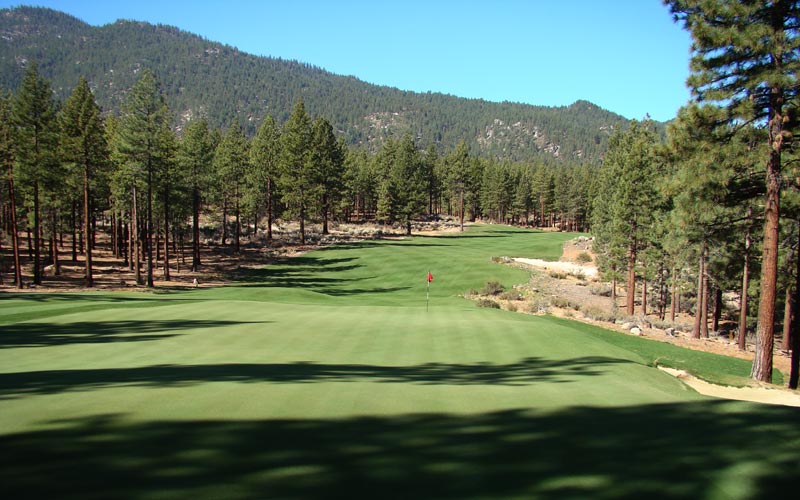
As seen from behind, the forty-eight long yard ninth green features over six feet (!) of slope from back to front, the most ever on a Coore & Crenshaw course.
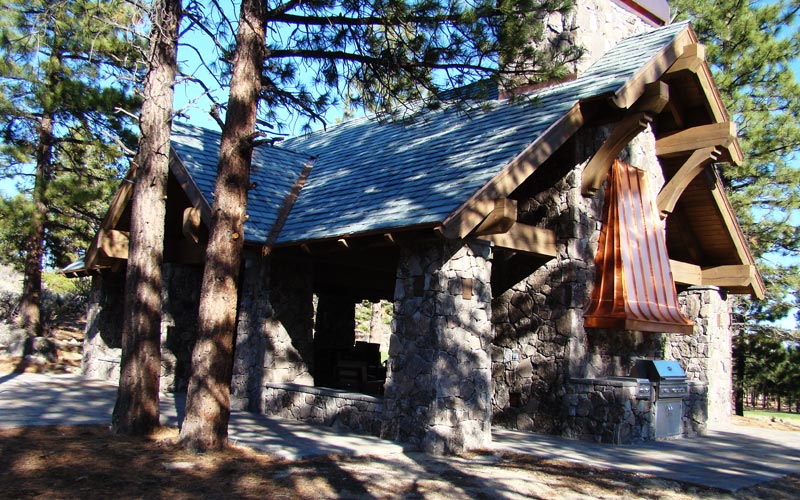
Though sub-four hour rounds are the norm, the open air halfway house above the tenth tee may prove too inviting to pass by.
Tenth hole, 470 yards, Swift’s Station; Here is text book example of building a hole for all skill levels. The wide fairway is only bunkered on one side (in this case the right) but that’s the best/shortest route home. Up ahead, the challenge stiffens at the green, though not in a forced or contrived manner. As seen below, the green is open in front and accepts all manners of approach shots. While the tiger golfer who carries the ball in this elevation 300 plus yards might only have a short iron in, he needs to be mightily aware of the green’s deep false front. Even approach shots that land twelve yards onto the green can spin back off. Played at 5,800 feet above sea level, the fact that Clear Creek measures just under 6,900 yards misleads some into entertaining false hopes of a low round. By the time they leave this green, such thoughts have generally been dispelled.
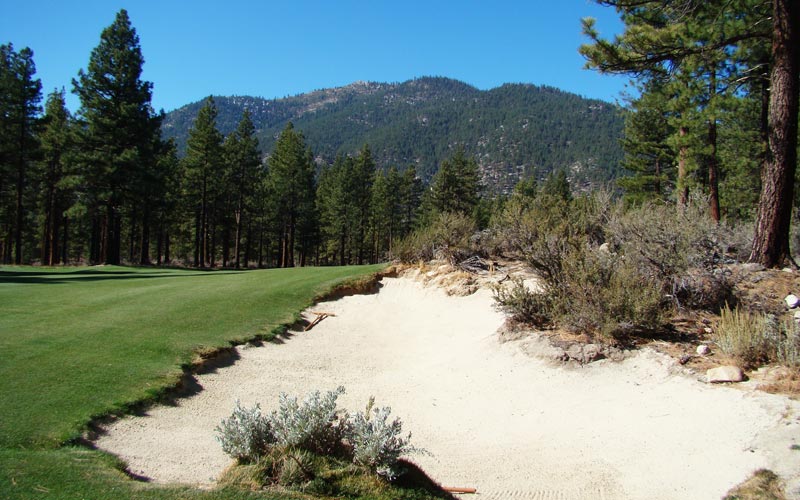
Though the golfer could hardly be farther from the sandbelt in Melbourne, Australia, he can be forgiven for thinking so based on how this bunker complete with native vegetation guards the best playing angle down a wide fairway.
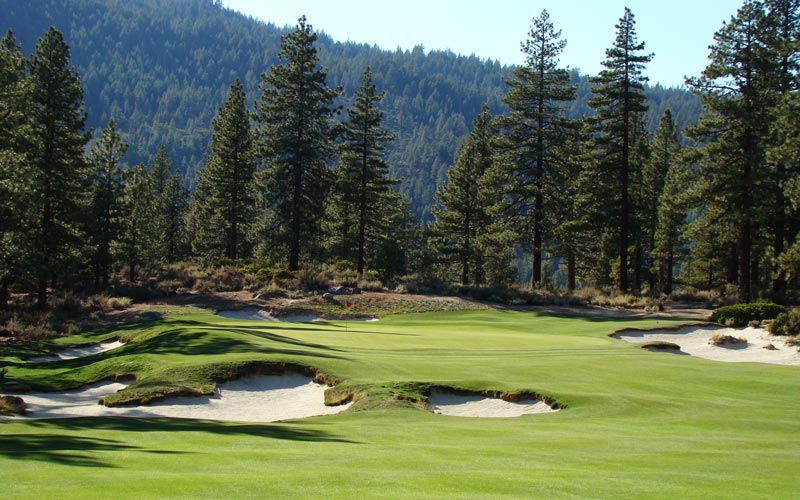
A picture perfect green site that will no doubt grace the cover of a book someday. The high brow of the bunker on the left masks the fact that there is over twenty yards past it before one reaches the putting surface. Just this side of the long shadow on the green is where the false front commences.
Eleventh hole, 425 yards, Reflection; The Lake Tahoe region is an obvious location for golf with its great vistas and low humidity. Yet of the current twenty-some courses, none were built in the same manner as this Coore & Crenshaw design where so little earth was moved. Though the front nine features the more pronounced changes in elevation, it might well be here where some golfers will feel the strongest affinity with nature.
Twelfth hole, 235 yards, Tarn; Of the five one shot holes, the bunkerless twelfth is not the most visually dramatic. Indeed, the high to low point on the hole is three feet! However, it perfectly complements the other one shotters and in fact, its putting surface is one of the three or four best on the entire course. High on each side, the large green helps to collect balls in toward it which is appropriate for a hole of such length. Would other architects have done something different? Yes. Would they have built a hole with any better golfing value? Doubtful.
Thirteenth hole, 590 yards, Contemplation; Mountain courses rarely play as well as they photograph because the soil is invariably rocky and drains poorly, which leads to playing conditions that are soft underfoot. As has been stated before, such is not the case here. In fact, there is no better place to gain an appreciation of the site’s sandy loam than to look at the large waste area 130 yards short left of the thirteenth green. As hard as it is to believe, this is the natural floor of the property where most of the holes are located. Its qualities are nothing short of ideal for golf.
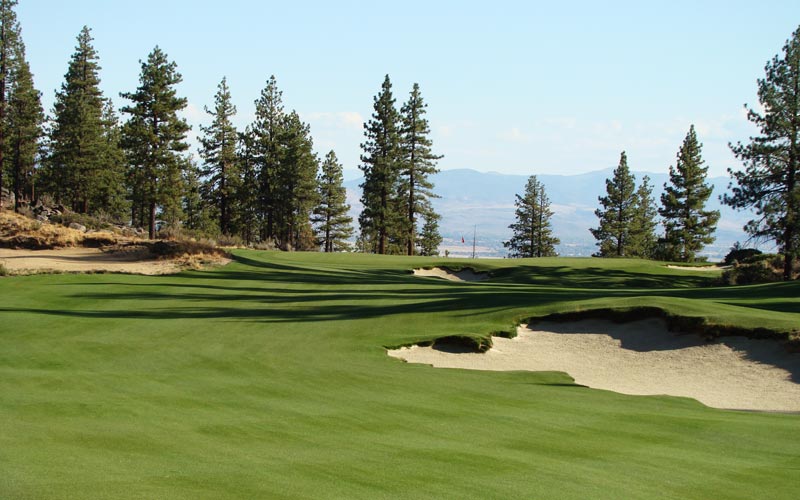
Play over the man-made bunker on the right in two and enjoy an unobstructed view of the green for one’s pitch approach. Play cautiously to the left and away from this hazard and…
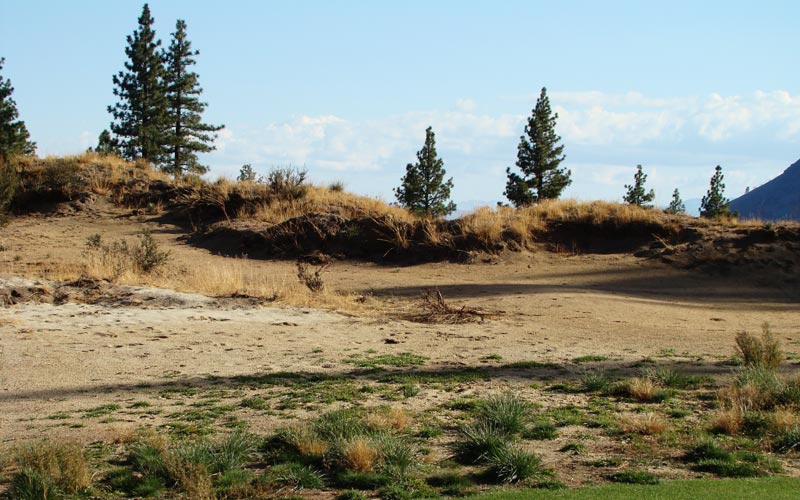
…face this blind shot to a wide but narrow green. Yes, amazingly, this is the natural floor of the property. If not for the pines (and the mountain peeking through on the right!), one might think the ocean was just beyond.
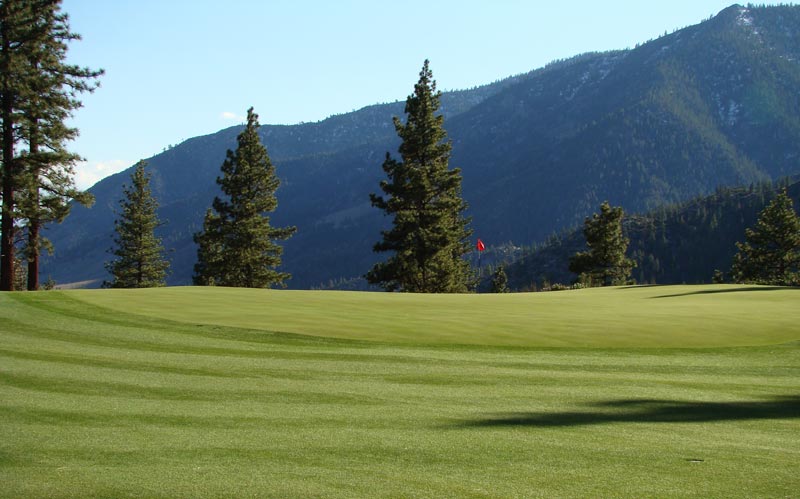
The select clearing of trees to open up views behind greens at Clear Creek was an art form. More so than on most holes, trees were felled to provide stunning views for fifteen plus miles in the distance as well as this view to the right of the Carson Range of the Sierras.
Fourteenth hole, 320 yards, Schneider’s Ditch; Courses establish their own identity through different ways. Some courses have greatness conferred upon them by hosting events, though often times it speaks more to the surrounding infrastructure than to any conspicuous merit of the course itself. Few architects have the ability to create original hazards that shear their way into the golfer’s mind and become a talking point among golf architecture cognoscenti. Be it greens like the ninth, fifteenth and seventeenth or the ditch behind this green or the natural sandy mounds prior to the seventeenth, there is plenty here that the golfer will have never seen before. Such unique challenges will stand Clear Creek in good stead for decades to come.
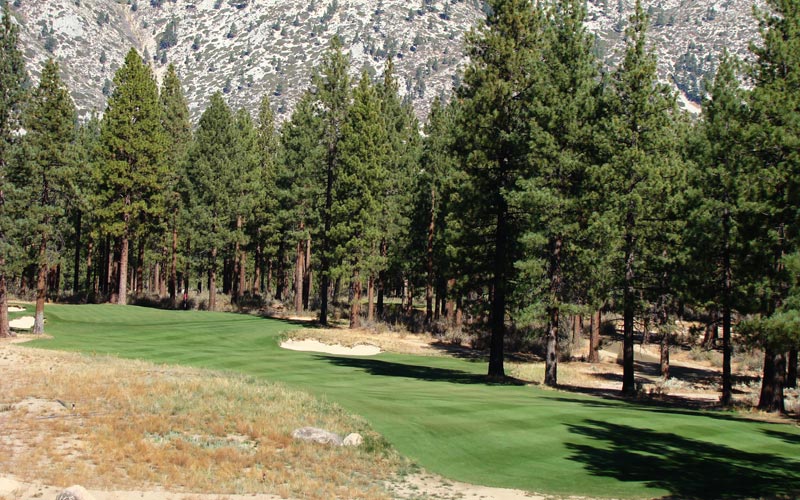
Coore & Crenshaw used a sandy dune to great effect by creating this fine diagonal carry off the fourteenth tee. Each golfer is free to make up his own mind as to which is the best line off the tee.
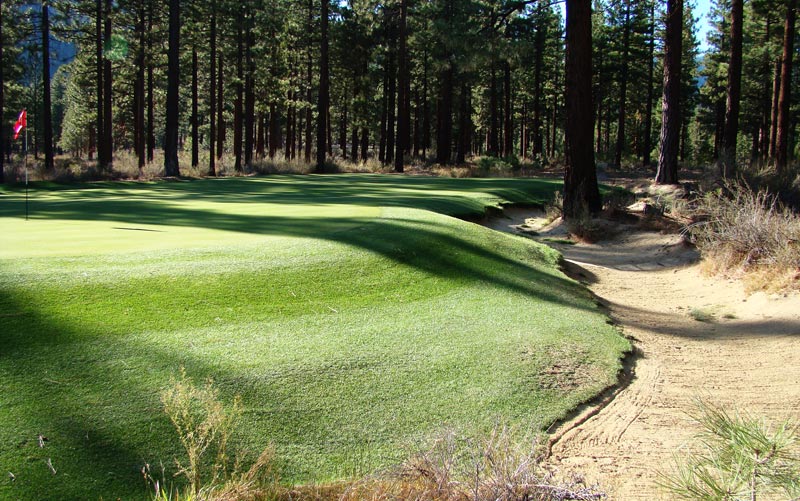
On a course full of ridiculously great long views, one of the most single interesting features is this tiny little trench bunker that wraps around the back of the fourteenth green. Few good things happen to the golfer once in it, especially given that his backswing is likely to be hampered.
Fifteenth hole, 450 yards, Double Cross; Ala the thirteenth at Augusta National, a hazard (in this case a dry ditch) runs in front of the tee and parallels the fairway down the left before crossing back in front of the green and hugging its right side. Not only is this dry ditch a fearsome hazard but it is also a thing of great beauty. Other modern clubs have gone the route of turning such hazards into active creeks for reasons that the author will never understand.
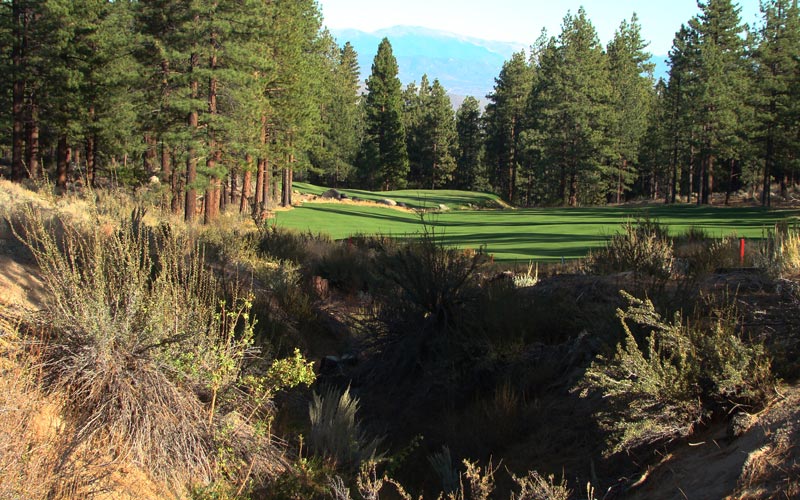
Mercifully, this fabulous dry ditch as seen down the left of the fifteenth fairway was left in its natural state.

This view from behind the fifteenth green shows how the green is high in front before falling away toward the back. Thus, a front hole location like this one can be quite vexing to get close, though a mound and short grass prior to the green gives the golfer a chance to do so.
Sixteenth hole, 435 yards, Slingshot; Just as few architects would have disturbed as little land as Coore and Crenshaw did around the quiet portion of the property at eleven, twelve and thirteen, few would have left this fairway alone, yet for entirely different reasons. Greeting the golfer off the sixteenth tee is a large hump in the fairway that careens tee balls every which way. Coore & Crenshaw could have easily done what most other architects would do, which would have been to greatly reduce this landform. Instead, they embraced it within the widest fairway on the course and left it so that the view of the green is blind until after the golfer gets beyond it. By capturing rather than obliterating this distinctive landform, they gave this hole its own standalone charm. Indeed, a trademark of every Coore & Crenshaw design is how rarely, if ever, two holes remind one of each other. This is certainly true of Clear Creek where no two holes are even remotely alike.
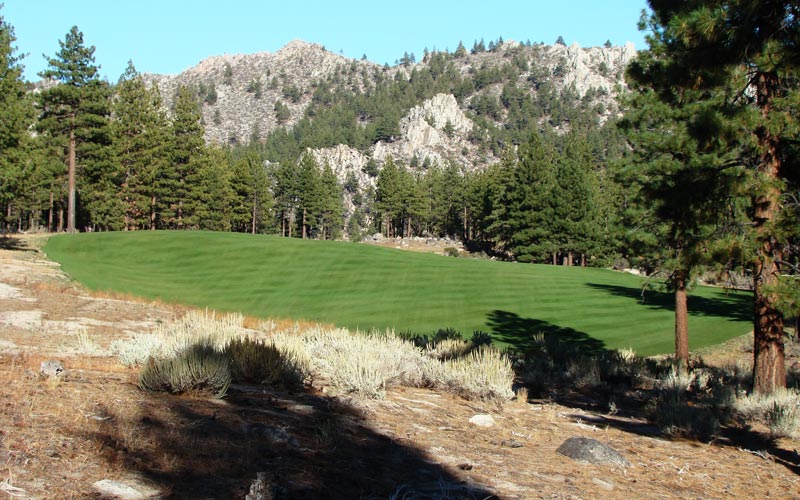
Coore & Crenshaw hate building holes where there is a clear dictate as to how it should be played. They much prefer designing holes that look like this off the tee: a wide fairway draped over an interesting landform. Depending on the shape shot one plays and where it hits in the sixteenth fairway, one’s tee ball can end up in innumerable different spots in the sixty plus yard wide fairway. In that manner, the sixteenth remains fresh, round after round, year after year.
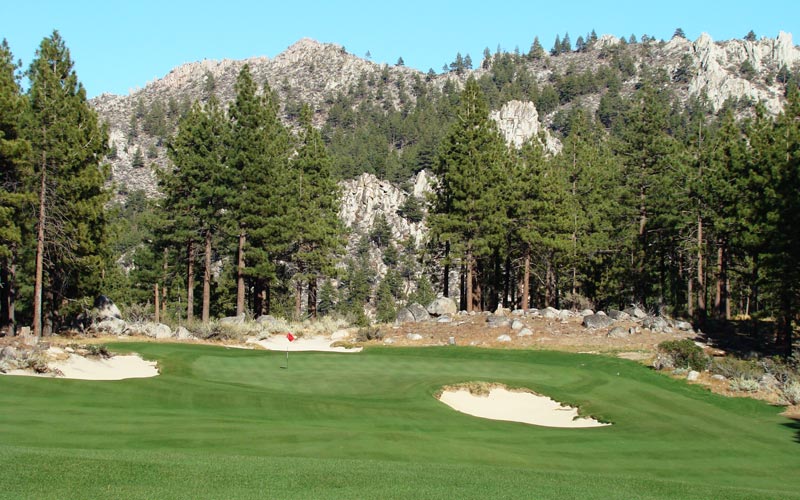
In a setting like this, it is incumbent on the architect to maximize the experience but never at the expense of good golf. The placement of the sixteenth green and the selective tree clearing that ensued provides a mighty backdrop. The deceptively long green makes depth perception a tricky affair while the right side of the green provides several sucker hole locations, not so much because of the right front bunker but because of the tight short grass on the bank that whisks slightly off balls ten plus yards away from the green and down the bank on the right.
Seventeenth hole, 150 yards, Temptation; Though Pete Dye helped lead golf course architecture out of the Dark Ages, even he was slow to move away from having water feature prominently on numerous penultimate holes. Indeed, the golfer could be forgiven for yawning if he came to a one shotter seventeenth that featured water as he had probably already played such a hole numerous times elsewhere before. What a shame it would be if this memorable course ended with a watery seventeenth and a long hard par four eighteenth. Fortunately, nothing could be further from the truth. The seventeenth measures 150 yards and plays even shorter thanks to the site’s elevation and twenty foot drop from tee to green. Though tiny, that’s not to imply that this hole is without challenge. Far from it. The fronting hazard may be the single most fearsome hazard on the entire course (which is appropriate given the hole’s length) and heaving contours found within the green provide all kinds of assistance in turning two putts into three or more. In fact, given these two outstanding design features, this hole quickly deserves to be included in any discussion of the world’s great short holes.

.. the rolling interior contours of the green tax the golfer as well as it falls away to the back through a trough.
Eighteenth hole, 530 yards, Tor; Variety within the different groups of holes (i.e. par threes, par fours and par fives) is an obvious laudable goal. The first par five at Clear Creek is a sharp dogleg left while the second one plays straightaway. The third and final one comes here at the Home hole and for the sake of balance and for not favoring any one shape shot over the other, it would be ideal if it was a dogleg to the right. Guess what? That’s what it is and if you think that is blind luck then you don’t appreciate how hard Coore works at a routing until he achieves an optimum balance whenever possible. While the hazards down the right are obvious places to avoid, so too is the tiny pot bunker in front of the green. Great swings of fortune can readily occur throughout the play of this Home hole, making it the kind of exciting finisher that leaves the golfer wanting to play more. In that manner, Coore & Crenshaw delivered exactly the kind of golf that Taylor and Hanly were keen to see for their members.
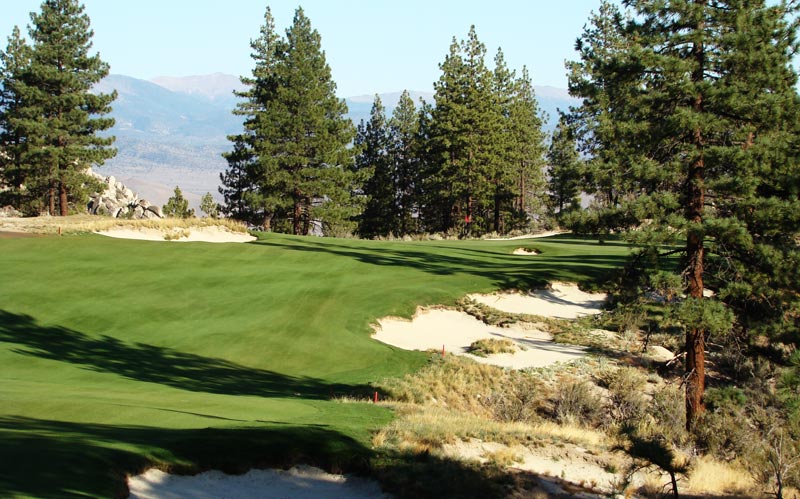
….right along the rim of a steep fall off. Flighting one’s ball over such fearsome hazards in hopes of reaching the green in two makes for a thrilling end to the round.
Apart from the golf, the Club at Clear Creek also offers flying fishing at the nearby West Walker Fly Fishing Ranch and a Lake House on Lake Tahoe with its own breathtaking setting. Nonetheless, the golf is still the focal part of the club’s offering. For those that played here in 2009 during its first season, everyone commented on the spectacular setting. In fact, the setting is so good that Coore & Crenshaw may never quite receive proper credit for the overall level of this design. And guess what? That’s the way they prefer it, with nature always front and center.
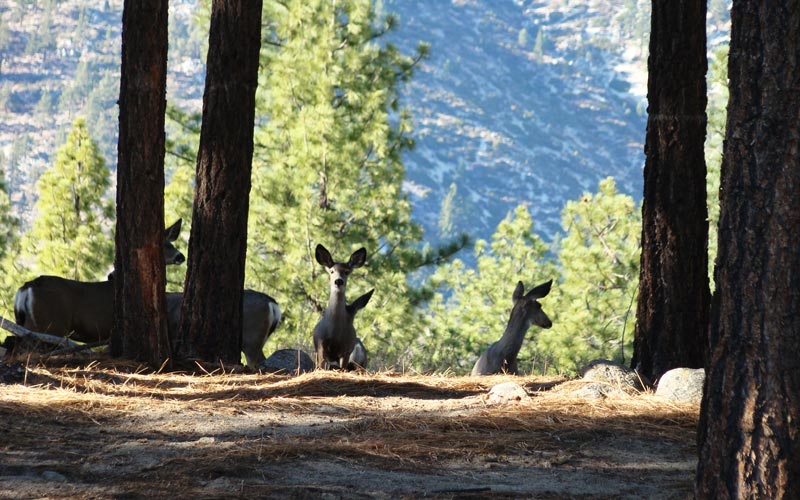
The only crowds at Clear Creek are of the four legged sort. With nothing to hear but the wind through the tall pines, the golfer is guaranteed a great environment in which to enjoy the game.
The End


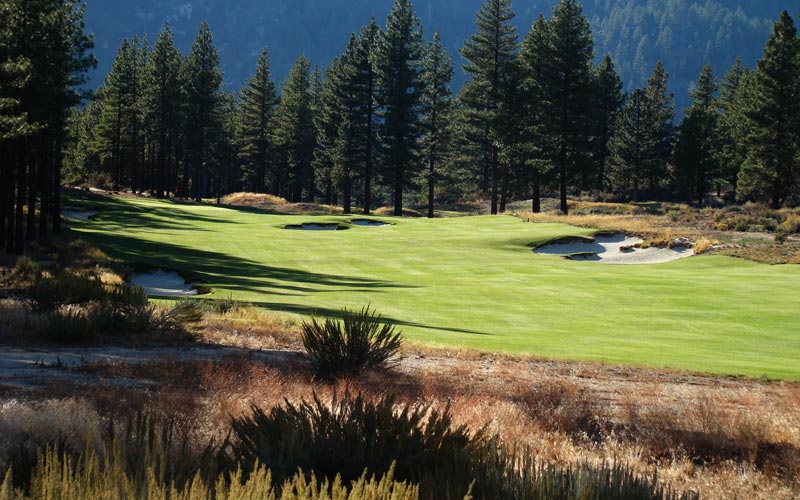

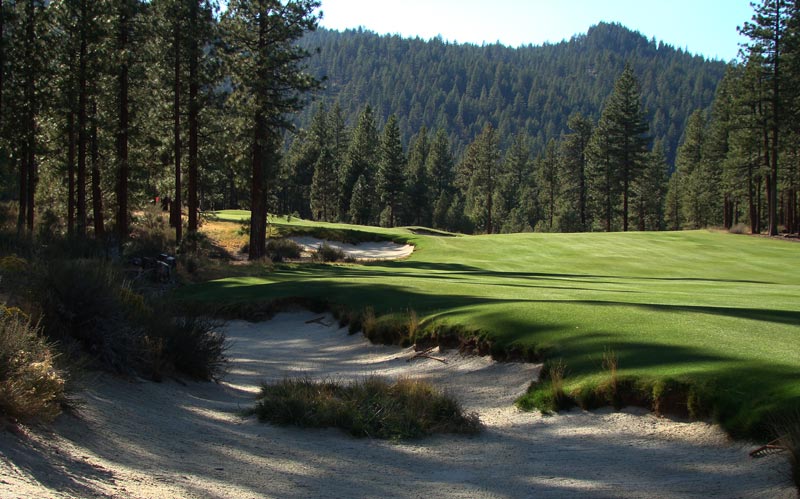

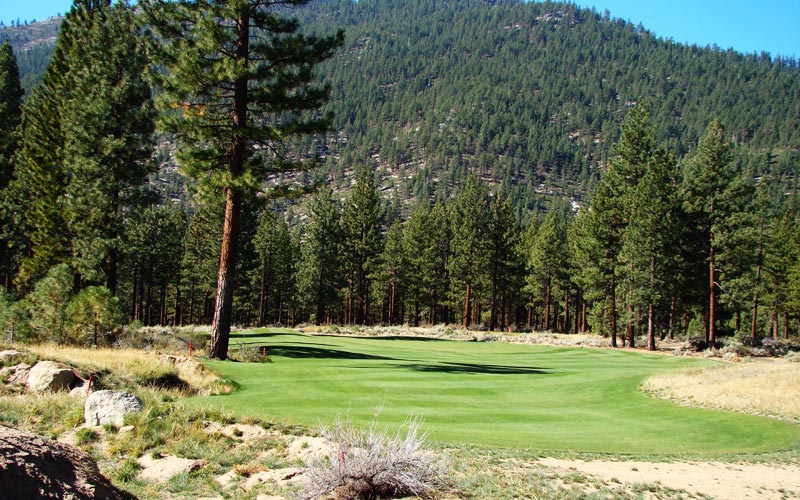


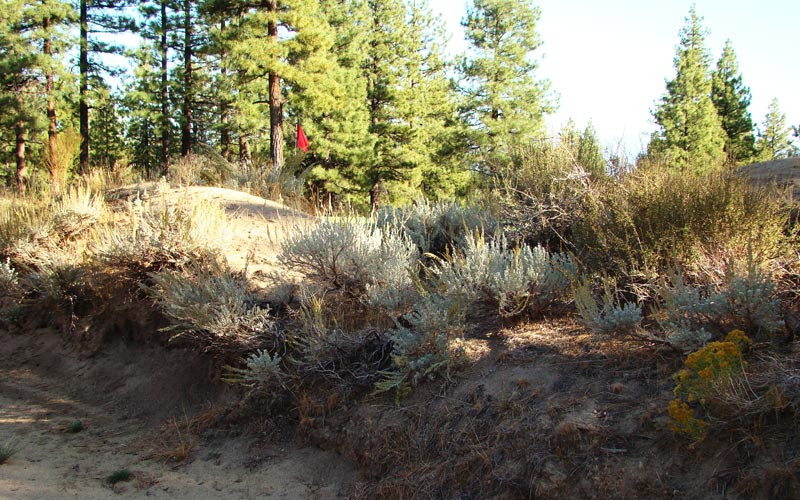
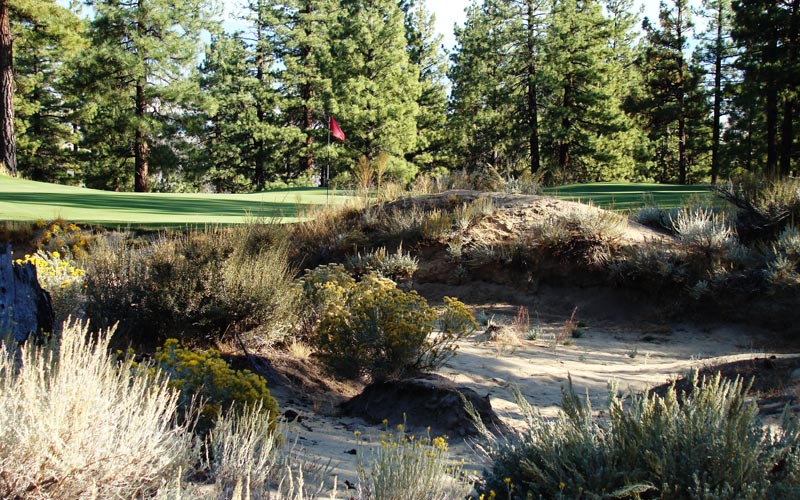
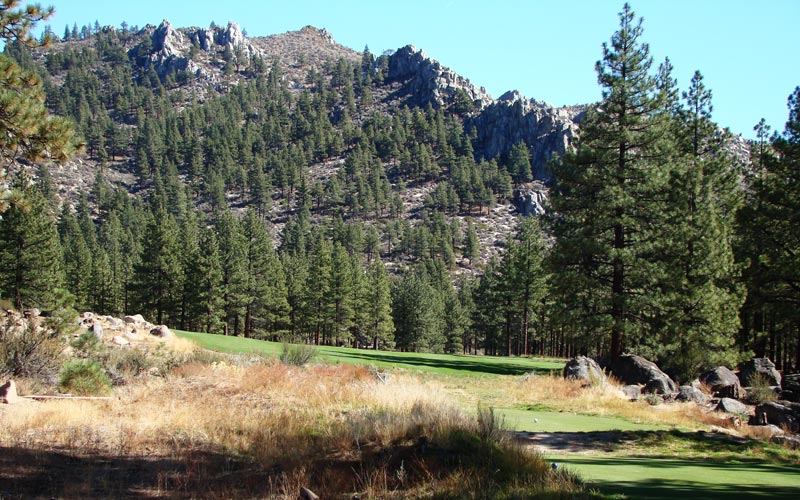


![The Park, West Palm (Lit 9) [2023]](https://golfclubatlas.com/wp-content/uploads/2024/12/IMG_7092-2-scaled-500x383.jpg)



